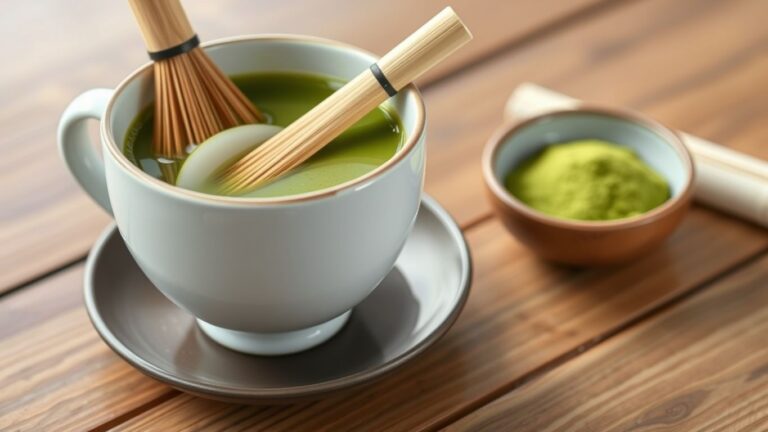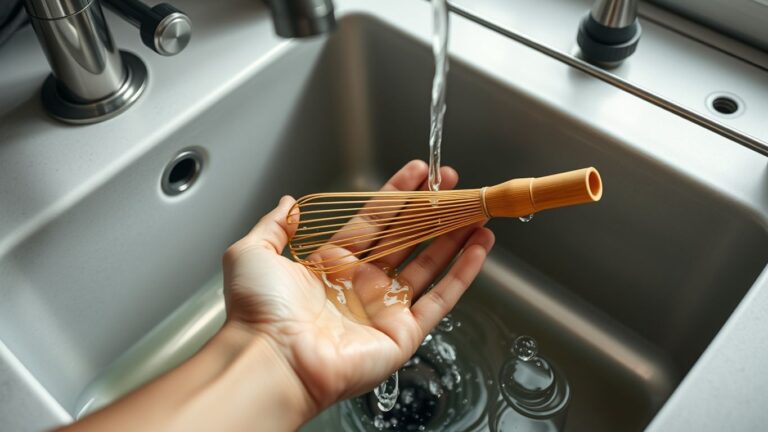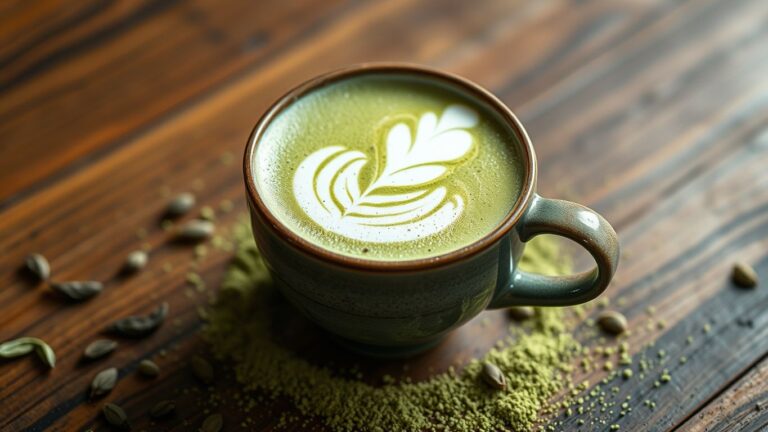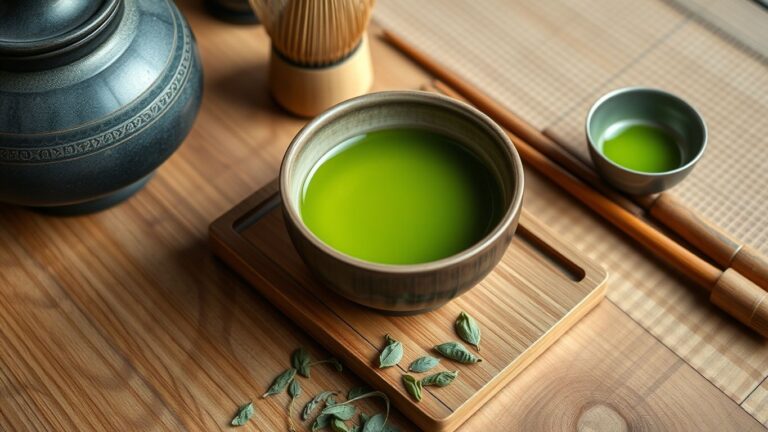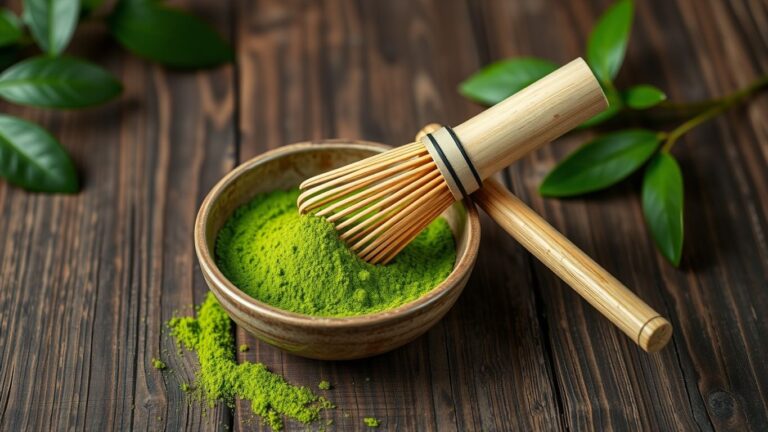Matcha ice cream is a delightful treat that brings together the unique flavors of matcha green tea and the creamy texture of ice cream. However, one common question is whether this tasty dessert contains caffeine. Understanding the caffeine content in matcha ice cream is important for those who are sensitive to caffeine or simply curious about what they are consuming. This article will explore everything you need to know about the caffeine in matcha ice cream, from its comparison to other ice creams to its health implications.
Key Takeaways
- Matcha ice cream does contain caffeine, as matcha powder is made from green tea leaves that naturally have caffeine.
- The caffeine content in matcha ice cream can vary based on the amount of matcha powder used in the recipe.
- Matcha ice cream generally has more caffeine than regular green tea ice cream but less than coffee ice cream.
- Homemade matcha ice cream allows you to control the caffeine content by adjusting the amount of matcha powder.
- Those sensitive to caffeine should be cautious when consuming matcha ice cream, especially in the evening.
Understanding Matcha and Its Caffeine Content

What is Matcha?
Matcha is a powdered green tea made from the leaves of the Camellia sinensis plant. Unlike regular green tea, where the leaves are steeped and then discarded, matcha involves consuming the entire leaf. This means you get more nutrients and caffeine from matcha compared to other teas.
How Matcha is Made
The process of making matcha starts with growing the tea plants in the shade for about three weeks before harvest. This increases the chlorophyll content, giving matcha its vibrant green color. After harvesting, the leaves are steamed, dried, and ground into a fine powder. This traditional method ensures that matcha retains its high levels of antioxidants and caffeine.
Caffeine Levels in Matcha
The caffeine content in matcha can vary depending on several factors, such as the type of leaves used and how much powder you consume. Generally, matcha contains 19–44 mg of caffeine per gram. A typical serving size is 2–4 grams, which means you could be consuming anywhere from 38 to 176 mg of caffeine in one serving. For comparison, an 8-ounce cup of coffee usually contains about 100 mg of caffeine. So, depending on the concentration, matcha can have a similar or even higher caffeine content than coffee.
Comparing Matcha Ice Cream to Other Ice Creams
Matcha vs. Green Tea Ice Cream
Matcha and green tea ice creams might seem similar, but they have distinct differences. Matcha ice cream uses finely ground matcha powder, giving it a more intense flavor and vibrant green color. Green tea ice cream, on the other hand, is made from brewed green tea, resulting in a lighter taste and color. Matcha is more concentrated, so you need less of it to achieve a robust flavor.
Matcha vs. Coffee Ice Cream
When comparing matcha ice cream to coffee ice cream, the caffeine content is a key factor. Coffee ice cream typically has higher caffeine levels due to the coffee used in its preparation. Matcha ice cream contains caffeine too, but in smaller amounts. The flavor profiles also differ significantly: matcha offers an earthy, slightly bitter taste, while coffee ice cream has a rich, roasted flavor.
Caffeine Content in Different Ice Creams
Here’s a quick comparison of the caffeine content in various ice creams:
| Ice Cream Type | Caffeine Content (mg per serving) |
|---|---|
| Matcha Ice Cream | 25-30 mg |
| Green Tea Ice Cream | 10-15 mg |
| Coffee Ice Cream | 50-60 mg |
As you can see, coffee ice cream has the highest caffeine content, followed by matcha, and then green tea ice cream. This makes matcha ice cream a moderate choice if you’re looking for a caffeine boost without going overboard.
If you’re sensitive to caffeine, you might want to opt for green tea ice cream or enjoy matcha ice cream in moderation.
Comparing these ice creams helps you understand the unique qualities of each, whether it’s the intense matcha flavor or the robust coffee taste.
The Science Behind Caffeine in Matcha Ice Cream
How Much Caffeine is in Matcha Ice Cream?
Matcha ice cream contains caffeine, but the amount can vary. Typically, a half-cup serving of matcha ice cream has about 48mg of caffeine. This is because matcha is made from whole tea leaves, which have more caffeine than regular green tea. Matcha has a proper amount of caffeine per serving, ranging from 19 to 44 milligrams per gram, depending on the quality and processing of the leaves.
Factors Affecting Caffeine Levels
Several factors can influence the caffeine content in matcha ice cream:
- Quality of Matcha: Higher quality matcha tends to have more caffeine.
- Amount Used: The more matcha powder used, the higher the caffeine content.
- Processing Methods: How the matcha is processed can also affect its caffeine levels.
Health Implications of Caffeine in Ice Cream
Consuming caffeine in ice cream can have both positive and negative effects. On the plus side, it can help you stay alert and reduce after-meal drowsiness. However, it might not be the best choice for those sensitive to caffeine, especially in the evening. If you’re looking to keep the party going, this recipe is a great way to counter after-meal drowsiness, so serve strategically and enjoy!
While matcha ice cream is a delicious treat, it’s important to be mindful of its caffeine content, especially if you are sensitive to caffeine or planning to enjoy it later in the day.
Making Your Own Matcha Ice Cream at Home

Ingredients Needed
To make homemade matcha ice cream, you’ll need just a few simple ingredients:
- 5 tbsp matcha powder
- 2 tsp hot water
- 4 oz Philadelphia cream cheese (1/2 brick), room temp
- 2 cups organic half-and-half
- 1 cup organic heavy cream
- 3/4 cup organic sugar
- 1 organic vanilla bean, split and scraped
Step-by-Step Recipe
- Prepare the Matcha Paste: Mix the matcha powder with hot water to form a smooth paste. This helps to avoid lumps when you add it to the larger liquid mixture.
- Combine Dairy and Sugar: In a large saucepan, combine the half-and-half, heavy cream, sugar, and the scraped vanilla bean pulp and pod. Place over medium heat and stir occasionally until the mixture just begins to simmer. Do not let it boil.
- Steep and Mix: Remove the mixture from heat and let it steep for 30 minutes. Then, remove the vanilla bean pod and whisk in the matcha paste until well incorporated.
- Chill the Mixture: Transfer the mixture into a lidded container and refrigerate for at least 4 hours, or overnight for best results.
- Churn the Ice Cream: Pour the chilled mixture into your ice cream maker and churn according to the manufacturer’s instructions.
- Freeze Before Serving: Once the ice cream reaches the desired consistency, transfer it back into a lidded container and freeze for at least one hour before serving.
Tips for the Perfect Matcha Ice Cream
- Buy the Right Matcha: Use culinary-grade matcha for the best flavor and color.
- Freeze Your Ice Cream Bowl: If using an ice cream maker, freeze the bowl for 24 hours beforehand to ensure proper churning.
- Make Matcha Paste: Always make a paste with matcha powder and a small amount of liquid to avoid lumps.
- Refrigerate the Mixture: Chilling the mixture for at least 4 hours helps achieve a smoother texture.
Making your own matcha ice cream at home is not only fun but also allows you to control the quality and flavor of the ingredients. Enjoy the process and the delicious results!
Commercial Matcha Ice Cream Brands
When it comes to enjoying matcha ice cream, you have plenty of options available in stores. Here’s a look at some popular brands, their caffeine content, and how they stack up in terms of taste and quality.
Health Benefits of Matcha Ice Cream

Nutritional Profile
Matcha ice cream provides the health benefits of matcha powder, including antioxidants, vitamins, and minerals. These nutrients can help support your overall health and well-being. Matcha is rich in catechins, a type of antioxidant that can help protect your cells from damage.
Antioxidant Properties
One of the standout features of matcha is its high antioxidant content. Antioxidants are important because they help neutralize harmful free radicals in your body. This can reduce inflammation and lower your risk of chronic diseases. Enjoying matcha ice cream can be a delicious way to boost your antioxidant intake.
Potential Health Risks
While matcha ice cream has many benefits, it’s important to consume it in moderation. The caffeine content in matcha can be a concern for some people, especially if you are sensitive to caffeine. Additionally, like all ice creams, matcha ice cream contains sugar and fat, which should be consumed in limited amounts to maintain a balanced diet.
Remember, enjoying matcha ice cream as part of a balanced diet can offer both pleasure and health benefits. Just be mindful of the portions and frequency to avoid any potential downsides.
Caffeine Sensitivity and Matcha Ice Cream
Who Should Avoid It?
If you’re sensitive to caffeine, you might want to think twice before indulging in matcha ice cream. The caffeine content in matcha can be quite high, making it a less ideal choice for those who experience jitters or insomnia from caffeine. It’s also not the best evening dessert option if you’re looking to wind down for the night.
Alternatives for Sensitive Individuals
For those who love the flavor of matcha but can’t handle the caffeine, there are alternatives. You can opt for decaffeinated green tea ice cream or even try making your own version using decaf matcha powder. Another option is to enjoy other flavors like vanilla or fruit-based ice creams, which are naturally caffeine-free.
How to Enjoy Matcha Ice Cream Responsibly
To enjoy matcha ice cream without overdoing the caffeine, consider these tips:
- Portion Control: Stick to a small serving size to limit your caffeine intake.
- Timing: Enjoy it earlier in the day rather than in the evening to avoid disrupting your sleep.
- Pairing: Combine it with foods that have calming effects, like a small piece of dark chocolate or a handful of nuts.
While matcha ice cream is a delicious treat, it’s important to consume it mindfully, especially if you’re sensitive to caffeine. By making smart choices, you can still enjoy this delightful dessert without the unwanted side effects.
Cultural Significance of Matcha Ice Cream
Matcha in Japanese Cuisine
Matcha, although now a quintessentially Japanese tea, actually originated in China. Japanese Buddhist monks who had been studying in the country found it helped them stay alert during meditation. Over time, matcha became deeply embedded in Japanese culture, especially in the traditional tea ceremony. Today, matcha is not just limited to tea but is also used in various sweets, including the beloved matcha ice cream.
Traditional vs. Modern Recipes
Traditional matcha ice cream recipes focus on preserving the authentic flavor of matcha. This means using high-quality matcha powder and avoiding artificial additives. Modern recipes, however, often experiment with additional ingredients like chocolate chips or fruit to create unique flavors. Both traditional and modern recipes have their own charm and cater to different tastes.
Global Popularity of Matcha Ice Cream
Matcha ice cream has gained global popularity, thanks to its unique flavor and health benefits. You can now find it in many countries outside Japan, from the United States to Europe. This global reach has also led to a variety of matcha ice cream products, ranging from premium artisanal options to more affordable commercial brands.
The rise of matcha ice cream worldwide is a testament to its delicious taste and the growing appreciation for Japanese culinary traditions.
Frequently Asked Questions About Matcha Ice Cream

Does Matcha Ice Cream Have Caffeine?
Yes, matcha ice cream does contain caffeine. Since matcha is a type of green tea, it naturally has caffeine. The amount of caffeine in matcha ice cream can vary depending on the amount of matcha used in the recipe. If you’re sensitive to caffeine, you might want to enjoy it in moderation.
How Does It Compare to Coffee Ice Cream?
When comparing matcha ice cream to coffee ice cream, the caffeine content is usually lower in matcha ice cream. Coffee ice cream often has a stronger and more bitter taste due to the coffee, while matcha ice cream has a more earthy and slightly sweet flavor. Both are delicious, but they offer different taste experiences.
Is It Safe for Children?
While matcha ice cream does contain caffeine, the amount is generally lower than in a cup of coffee. However, it’s still a good idea to limit the amount of matcha ice cream children consume, especially if they are sensitive to caffeine. Always check the specific caffeine content if you’re concerned.
If you’re looking for a treat without caffeine for your kids, consider other flavors like vanilla or chocolate. They can still enjoy a delicious ice cream without the caffeine.
What Do I Do If Some of the Matcha Sticks to the Sides of the Blender?
If you find that some of the matcha sticks to the sides of the blender, you can use a spatula to scrape it down and mix it back into the ice cream mixture. This ensures that you get all the matcha flavor evenly distributed throughout your ice cream. Don’t worry if a little bit sticks; it’s a common issue and easily fixed.
Exploring Matcha Ice Cream Recipes
Classic Matcha Ice Cream
Creating classic matcha ice cream at home is easier than you might think. You’ll need just a few simple ingredients:
- 2 cups organic half-and-half
- 1 cup organic heavy cream
- 3/4 cup organic sugar
- 1 organic vanilla bean, split and scraped
- 3 Tbsp. organic matcha tea
Steps to make it:
- Combine half-and-half, cream, sugar, and vanilla bean pulp in a large saucepan over medium heat.
- Stir occasionally until the mixture just begins to simmer. Do not boil.
- Remove from heat and let it steep for 30 minutes.
- Remove the vanilla bean pod and whisk in the matcha tea until well incorporated.
- Transfer the mixture to a lidded container and refrigerate overnight.
- Pour the mixture into an ice cream maker and churn according to the manufacturer’s instructions.
- Once the desired consistency is reached, transfer back to the lidded container and freeze for at least one hour before serving.
Vegan Matcha Ice Cream
For those who prefer a dairy-free option, vegan matcha ice cream is a delicious alternative. Here’s what you’ll need:
- 2 cups coconut milk
- 1 cup almond milk
- 3/4 cup organic sugar
- 3 Tbsp. organic matcha tea
Steps to make it:
- Combine coconut milk, almond milk, and sugar in a saucepan over medium heat.
- Stir until the sugar is dissolved and the mixture is warm.
- Remove from heat and whisk in the matcha tea.
- Transfer to a lidded container and refrigerate overnight.
- Churn in an ice cream maker according to the manufacturer’s instructions.
- Freeze for at least one hour before serving.
No-Churn Matcha Ice Cream
No ice cream maker? No problem! You can still enjoy homemade matcha ice cream with this no-churn recipe. You’ll need:
- 2 cups heavy cream
- 1 can (14 oz) sweetened condensed milk
- 3 Tbsp. organic matcha tea
Steps to make it:
- Whip the heavy cream until stiff peaks form.
- In a separate bowl, mix the sweetened condensed milk and matcha tea until well combined.
- Gently fold the whipped cream into the matcha mixture.
- Pour into a lidded container and freeze for at least 6 hours or until firm.
Making your own matcha ice cream at home allows you to control the ingredients and customize the flavor to your liking. Whether you prefer the classic, vegan, or no-churn version, there’s a recipe for everyone to enjoy.
Enjoy experimenting with these recipes and find your favorite way to savor this delightful treat!
The Future of Matcha Ice Cream
Innovative Flavors and Combinations
As matcha ice cream continues to gain popularity, expect to see more creative flavors and combinations. Imagine matcha paired with unique ingredients like microgreens or even savory elements like parmigiano. These innovative twists will keep matcha ice cream exciting and fresh.
Sustainability in Matcha Production
Sustainability is becoming a key focus in the food industry, and matcha production is no exception. Efforts are being made to ensure that matcha is grown and harvested in environmentally friendly ways. This includes using organic farming practices and reducing the carbon footprint of matcha production.
Market Trends and Consumer Preferences
The demand for matcha ice cream is on the rise, and this trend is expected to continue. Consumers are increasingly looking for healthier and more natural dessert options, and matcha ice cream fits the bill perfectly. Keep an eye out for new brands and products that cater to this growing market.
Conclusion
In summary, matcha ice cream does contain caffeine, thanks to the matcha powder used in its preparation. This makes it a delightful treat that can also give you a gentle energy boost. However, if you’re sensitive to caffeine or planning to enjoy it late in the evening, you might want to consider this. The unique flavor of matcha, with its earthy and slightly bitter notes, combined with the creamy texture of ice cream, offers a refreshing and invigorating experience. So, whether you’re a matcha enthusiast or just curious, give matcha ice cream a try and savor its distinct taste and benefits!
Frequently Asked Questions
Does Matcha Ice Cream Contain Caffeine?
Yes, matcha ice cream does contain caffeine because it is made with matcha powder, which has caffeine.
How Much Caffeine is in Matcha Ice Cream?
The amount of caffeine in matcha ice cream can vary, but a half-cup serving typically contains around 48mg of caffeine.
Is Matcha Ice Cream Safe for Children?
Due to its caffeine content, matcha ice cream may not be suitable for young children or those sensitive to caffeine.
How Does Matcha Ice Cream Compare to Coffee Ice Cream in Terms of Caffeine?
Matcha ice cream usually has less caffeine than coffee ice cream. Coffee ice cream can have up to 95mg of caffeine per serving, while matcha ice cream has about 48mg.
Can I Make Matcha Ice Cream at Home?
Yes, you can make matcha ice cream at home using simple ingredients like matcha powder, milk, cream, and sugar.
What Are the Health Benefits of Matcha Ice Cream?
Matcha ice cream contains antioxidants from the matcha powder, which can help protect your cells from damage.
Are There Vegan Options for Matcha Ice Cream?
Yes, you can make vegan matcha ice cream using plant-based milk and cream alternatives.
What Does Matcha Ice Cream Taste Like?
Matcha ice cream has a unique flavor that is earthy, slightly bitter, and sweet. It also has a creamy texture.

